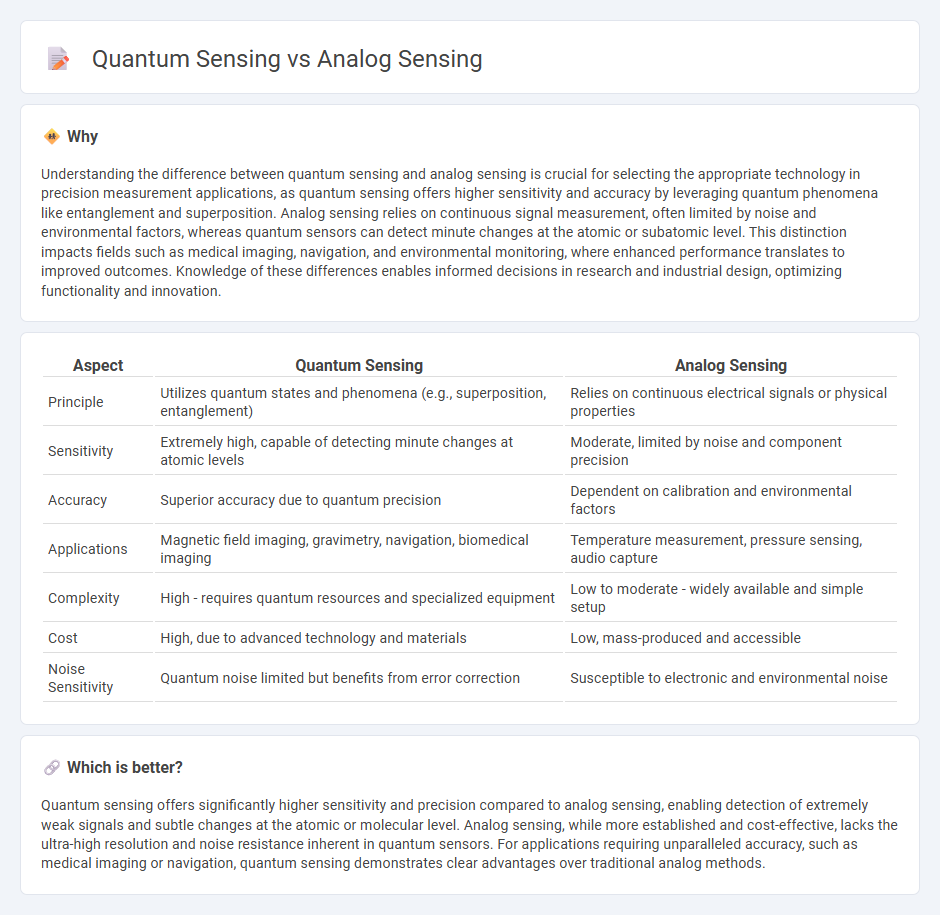
Quantum sensing exploits the principles of quantum mechanics to achieve unprecedented sensitivity and accuracy beyond the limits of classical analog sensors. Unlike traditional analog sensing, which relies on continuous signals and classical physical phenomena, quantum sensors utilize quantum states such as superposition and entanglement to detect minute changes in physical quantities. Explore how quantum sensing is transforming measurement technologies and unlocking new possibilities in fields like medical imaging, navigation, and fundamental physics.
Why it is important
Understanding the difference between quantum sensing and analog sensing is crucial for selecting the appropriate technology in precision measurement applications, as quantum sensing offers higher sensitivity and accuracy by leveraging quantum phenomena like entanglement and superposition. Analog sensing relies on continuous signal measurement, often limited by noise and environmental factors, whereas quantum sensors can detect minute changes at the atomic or subatomic level. This distinction impacts fields such as medical imaging, navigation, and environmental monitoring, where enhanced performance translates to improved outcomes. Knowledge of these differences enables informed decisions in research and industrial design, optimizing functionality and innovation.
Comparison Table
| Aspect | Quantum Sensing | Analog Sensing |
|---|---|---|
| Principle | Utilizes quantum states and phenomena (e.g., superposition, entanglement) | Relies on continuous electrical signals or physical properties |
| Sensitivity | Extremely high, capable of detecting minute changes at atomic levels | Moderate, limited by noise and component precision |
| Accuracy | Superior accuracy due to quantum precision | Dependent on calibration and environmental factors |
| Applications | Magnetic field imaging, gravimetry, navigation, biomedical imaging | Temperature measurement, pressure sensing, audio capture |
| Complexity | High - requires quantum resources and specialized equipment | Low to moderate - widely available and simple setup |
| Cost | High, due to advanced technology and materials | Low, mass-produced and accessible |
| Noise Sensitivity | Quantum noise limited but benefits from error correction | Susceptible to electronic and environmental noise |
Which is better?
Quantum sensing offers significantly higher sensitivity and precision compared to analog sensing, enabling detection of extremely weak signals and subtle changes at the atomic or molecular level. Analog sensing, while more established and cost-effective, lacks the ultra-high resolution and noise resistance inherent in quantum sensors. For applications requiring unparalleled accuracy, such as medical imaging or navigation, quantum sensing demonstrates clear advantages over traditional analog methods.
Connection
Quantum sensing and analog sensing are connected through their shared goal of detecting physical quantities with high precision and sensitivity, but quantum sensing leverages quantum phenomena like superposition and entanglement to surpass classical limits inherent in analog sensing. Analog sensors measure continuous signals directly, while quantum sensors exploit quantum states to enhance measurement resolution beyond classical noise constraints. Integrating analog techniques with quantum sensing frameworks improves accuracy in applications such as magnetic field detection, inertial navigation, and medical imaging.
Key Terms
Signal Resolution
Analog sensing typically offers signal resolution limited by noise and hardware precision, making it effective for many everyday applications but less sensitive to minute changes. Quantum sensing leverages quantum phenomena such as superposition and entanglement, achieving significantly higher signal resolution and sensitivity beyond classical limits, ideal for tasks like magnetic resonance imaging or gravitational wave detection. Explore the advancements in quantum sensing technology to understand its transformative impact on signal resolution.
Measurement Precision
Analog sensing relies on continuous signal measurement, often limited by thermal noise and hardware imperfections, which constrain measurement precision to a finite resolution. Quantum sensing exploits quantum phenomena such as superposition and entanglement, enabling measurement precision beyond classical limits, often reaching the Heisenberg limit for enhanced sensitivity. Explore the advancements in quantum sensing technology to understand how it surpasses traditional analog methods in critical precision applications.
Noise Sensitivity
Analog sensing devices experience significant noise sensitivity due to environmental interferences and signal degradation, leading to limited precision and reliability in measurements. Quantum sensing exploits quantum properties like entanglement and superposition to achieve superior noise resilience and sensitivity, making it ideal for detecting extremely weak signals with high accuracy. Explore the advancements in quantum sensing technologies to understand how noise sensitivity challenges are being overcome effectively.
Source and External Links
Choosing Between Analog and Digital Sensors: Cost & Performance - Analog sensors provide a continuous output signal directly proportional to the measured parameter, useful for real-time monitoring of physical quantities like temperature, pressure, and strain, though they are sensitive to noise and environmental factors affecting precision.
What's the Difference Between Analog and Digital Sensors? - Analog sensors generate continuous signals representing quantities such as speed, pressure, and temperature, offering immediate and continuous readings that are slightly more accurate but with fewer built-in features than digital sensors.
Different Types of Analog Sensors & How To Choose One | Veris - Analog sensors commonly use signals like 0-10V or 4-20mA for transmitting measurements in industrial settings, with voltage or current outputs tailored for control systems and automation processes.
 dowidth.com
dowidth.com